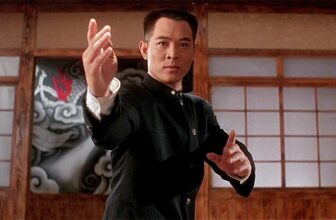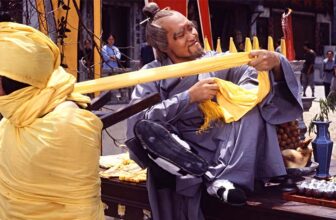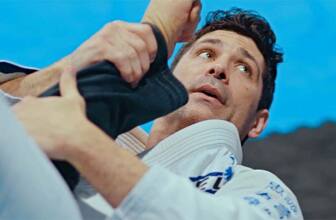
“Choke” is a seminal documentary directed by Robert Goodman, which follows three fighters through a Vale Tudo (no-holds-barred) competition, taking place in Japan in 1995.
One of these fighters is MMA legend and member of Brazilian Ju-Jitsu royalty, Rickson Gracie. Rickson had a reported 401 wins before this competition, and went on to be inducted into the Mixed Martial Arts hall of fame.
Our other two protagonists are; Koichiro Kimura, a Japanese Jiu-Jitsu and shoot fighter, and Todd Hays, a kick boxer and Olympic bobsled hopeful (yes, really!).
The film gives us a personal look at the fighters’ preparation for the tournament, following their individual narratives, which lends the audience emotional investment on through to a brutal competition which provides the film’s climax.
Cast
The focus remains mostly on Rickson, and his mission to spread BJJ as an art form and prove its effectiveness to the world.
We see him training his own students at his academy where one student provides an almost unbelievable account of his master’s skills. BJJ Grandmaster Helio Gracie provides a short interview noting the importance of what Rickson’s success will do for martial arts.
Rickson is a bubbly and playful character, who is also focused, humble and of course, supremely talented. Our second fighter is Todd Hays, an ambitious fighter who is using prize fighting as a way to fund his dream of competing for the US bobsled team in the Olympics. Todd trains hard and is an excellent striker with impressive strength.
Koichiro Kimura is a placid Japanese Jiu-Jitsu fighter, we see him at home with his parents who describe the anxiety they hold about him dying in the ring, fostered by Vale Tudo’s apparent lack of rules. Kimura is a competent grappler with a valiant fighting spirit.
Plot
Each fighter’s training camp follows them through different stages of training. We see each fighter at their home training camp, sharpening their skills and showing off their particular talents.
Several interviews feature with coaches and people around the fighters, some of which are very indicative about the martial arts game. Much of this section of the film serves to build tension for the competition in which the fighters will potentially face each other; there is an obvious fear of Rickson who was defending champion in the competition.
Certain parts of the film seem to be trying to expose the personal motivations and backgrounds of the characters that make them the fighters they are; this creates an immersive narrative that gives the film a more personal edge as opposed to a simple exposé of a brutal combat sport.
When the fighters move their training camps to Japan in the latter days of preparation, we see an intimate interview with Rickson and his wife where they talk about how their lives are affected by fighting, this includes food, their love life and the fear that looms over the family due to the danger of combat.
The film’s climax is an edited 30-minute version of the tournament itself, on one evening at Japan’s famous Budokan arena, an impressive purpose-built venue. Whilst the fights happen, we see highlights from the action while following the three protagonists backstage. The focus is not only on the preparation for the fights but also how the results of other fighter’s bouts affect each fighter, including running commentary from the characters themselves.
This results in a dramatic and immersive sequence filled with twists, turns, surprises, crashes and glories. The fighting is superbly documented, with clear vision of the action due to the framing of the camera, and added excitement from the fast-paced editing and music.
Action
Apart from the cool training scenes, which include an amazingly progressive and artistic workout from Rickson, the film’s main action comes at the end in an eye opening sequence of the competition night.
We see highlights from all the featured fighters, and two amazing David vs. Goliath style wars featuring a tiny Japanese shoot fighter called Yuki Nakai, who becomes somewhat of an unexpected hero in the film. Nakai eventually faces Rickson in the final, despite having a swollen eye from an eye-gouge in his first fight, against a gigantic Savate kickboxing world champion.
Our two secondary protagonists meet at one stage in a tense and dramatic bout with an equally dramatic follow up. Much of the interest of the competition is that they are still style vs. style based fights which were prevalent in the early days of mixed martial arts, meaning that fighters have particular and individual skill sets as opposed to being well-rounded athletes. Rickson, as expected, displays phenomenal talent and power. His grappling skills, which give the film its title, shine and are certainly enthralling to watch.
Summary
Choke is an excellent documentary about the beginnings of mixed martial arts. We are given an interesting look at real people, witnessing how these people live their lives as professional fighters, as well as what it means to them and their families’ futures.
With some awesome training, brutal fighting and distinguished fighting talent, Choke is one of the better quality martial arts documentaries out there and a must-see for any MMA, BJJ or general martial arts fan.
Trivia
- One of the film’s featured fighters, Todd Hays, eventually fulfilled his dream of becoming an Olympic bobsledder and won silver at the 2002 Winter Olympic Games in Salt Lake City.
- Rickson Gracie featured as the martial arts instructor of ‘the hulk’ in the 2008 movie “The Incredible Hulk” starring Edward Norton.
- ‘Vale Tudo’ translates from Portuguese as ‘anything goes’.
- The eye-gouge which Yuki Nakai suffered at the hands of Gerard Gordeau actually left Nakai with permanent loss of vision in his left eye.






